Jigsaw puzzles from Japan
Index to Artists
On this page: Best-selling artists - Traditional painters - Illustration - Fantasy - Photographers - About Japanese names
A list of all Japanese artists whose work features on our puzzles, including not only painters and illustrators, but also photographers (but excluding anime for now). If you are looking for other examples of the artist's work, try the link to search at Google for the name in Japanese.
Artists' names are written in various orders, but the family name is always underlined.
Please note that the enlarged signature illustration may be that on a different puzzle from the sample shown.
Best-selling artists
Morita Haruyo
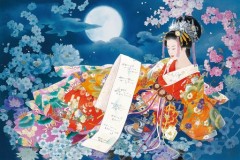
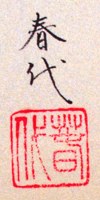
Haruyo: signature and seal
The artist Morita Haruyo studied both Japanese art and kimono design, and she combines these with elements of her own Western-influenced technique. (She travelled to London in 1977, exactly the year I [Brian Chandler] first came to Tokyo.)
Morita is her family name: she follows the tradition of signing - and sealing - paintings with her given name only.
Search at Google for the artist's name in Japanese
Fujishiro Seiji
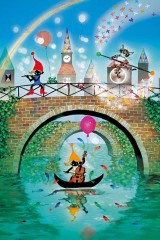
Born in 1924, Fujishiro has had a long and productive career as an illustrator - producing many children's books, and creating his own brand of fantasy along the way. From an early involvement with shadow puppetry, he developed his own unique style: he calls these kage-e (literally "shadow pictures"), but his is a backlit world not of black and white (or grey), but of wonderful translucent colours, apparently made mostly from tissue paper.
As of January 2020, he is still active in his nineties, and his work has appeared all over the world.
Search at Google for the artist's name in Japanese
Harai Kayomi
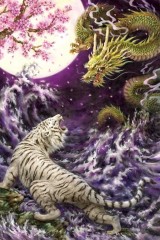
No biographical details available. She signs her given name Kayomi in Roman letters.
Search at Google for the artist's name in Japanese
Shu Mizoguchi

Born in Hiroshima in 1972, the artist developed his talent for original art while working as a graphic artist for a game company. He is now an independent creator of fantasy works.
Mizoguchi is his family name; he signs his work "Shu", the short form of his given name (Shuichi). On the box his name is given as "SHU Mizoguchi", somewhat confusingly, given the recent trend to writing the family name first capitalized.
Search at Google for the artist's name in Japanese
Takaki
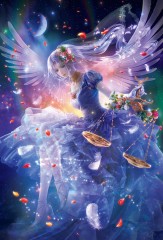
Born in Hokkaido in 1974, as a child the artist Takaki was fascinated by birds, so wings feature in many of her images. She became a protégée of Kagaya, and has produced many fantastic images.
Search at Google for the artist's name in Japanese
Traditional
Ozuma Kaname
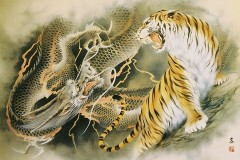
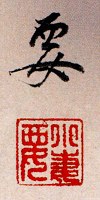
Signed Kaname with full-name seal
The painter Ozuma Kaname was born in 1939, in Niigata. He studied traditional Japanese art, and his pictures are generally based on traditional themes.
Ozuma is his family name: he signs paintings with the single character of his given name only.
Search at Google for the artist's name in Japanese
Katsushika Hokusai
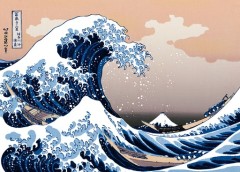
The artist Katsushika Hokusai is best known for his series of 36 views of Mount Fuji, in the bold and simple style of the Ukiyo-e (or "floating world") style. He changed his name several times, so this is only the best-known of his brush names; as is the tradition, Hokusai is his given name (a fact that has plainly confused at least one art reference book).
Search at Google for the artist's name in Japanese
Tōshūsai Sharaku
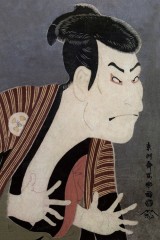

Full name (5 characters) plus 'ga' ("drew") and a publisher's(?) seal
Very little of certainty is known about Sharaku (this is his given name, though it is very likely no-one's real name; his family name, Tōshūsai, is rarely used at all). His works, caricatures of kabuki artists, appeared over the space of less than a year from mid-1794, and then he totally disappeared. Theories abound!
Search at Google for the artist's name in Japanese
Sekiguchi Inoichirô
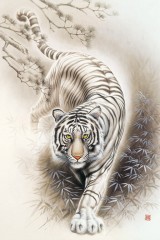
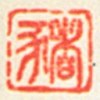
Ino seal
No details of this artist are readily available. He signs his paintings with a seal for the first character ('Ino') of his given name only: this means 'wild boar', which might seem surprising, but it is a fairly common element in names.
Search at Google for the artist's name in Japanese
Takeuchi Hakuga
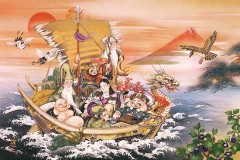
The artist was born in 1948, in Niigata. After working for a textile company, he went independent as a textile designer. He has his own individual drawing style, bringing a fresh approach to many traditional art themes.
He goes by his given name, Hakuga, in the traditional way, signing his paintings in a stylised, but non-cursive form.
Search at Google for the artist's name in Japanese
Mori Seikaku
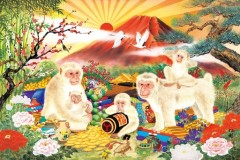
No biographical details, but the artist Mori Seikaku specialises in animal and flower scroll paintings. He signs his work the traditional way, with the characters for his given (brush) name, Seikaku (lit. 'nest of the crane') and a seal of the same.
Search at Google for the artist's name in Japanese
Kitagawa Utamaro
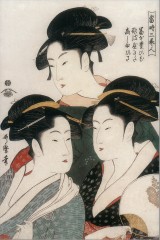
Born around 1753, Utamaro was one of the most successful woodblock artists in his own time, specialising in sensuous portraits of women.
Search at Google for the artist's name in Japanese
Utagawa Hiroshige

Hiroshige (1797 – 1858) was inspired by seeing the landscape images of Hokusai, to whom he became a younger rival. He joined the flourishing Utagawa school, and produced thousands of woodblock prints, using the most advanced techniques of the time. He is most famous for his series "The 53 stations of the Tokaido."
He is usually known as Utagawa Hiroshige, being his brush name within the school, but he was born into a low-ranking samurai family (with the job of fireman), and so is also sometimes known by his real family name, Ando.
Search at Google for the artist's name in Japanese
Kayama Ryokusui
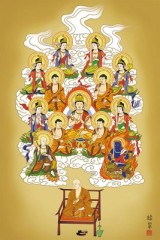
Very little biographical information to be found on the artist Kayama Ryokusui, who specialises in traditional Japanese styles, particularly of kakemono scrolls. Kayama is an ordinary family name, but Ryokusui is almost certainly a "brush name", consisting of two characters which both mean "green".
Search at Google for the artist's name in Japanese
Ukai Yuhei
No biographical information is to be found on the artist Ukai Yuhei, another of the craft producers of traditional images particularly for kakemono scrolls. He signs his work the traditional way, with his given name Yuhei, and a seal of the same.
Search at Google for the artist's name in Japanese
Jun Sato
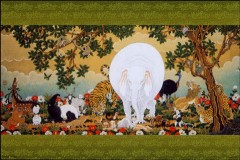
Born in Osaka in 1970, Jun Sato specialises in portraying the animal world, in a lively style, but one inspired by traditional Japanese paintings.
Search at Google for the artist's name in Japanese
Toyama Hiroko
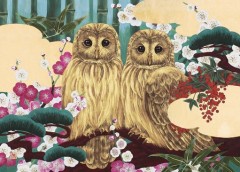
Born in Miyagi, northern Japan in 1984, Toyama Hiroko (Toyama is her family name) specialises in birds and flowers, bringing a modern touch along with many traditional stylisations.
Search at Google for the artist's name in Japanese
Itō Jakuchū
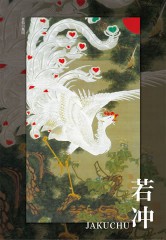
Jakuchū (1716–1800) was a Japanese painter in the Edo period when Japan was closed to the outside world. He painted traditional subjects, particularly birds, and seems to have been particularly fond of chickens.
Itō is his family name; as was common at the time, the name Jakuchū was not his birthname, but a brush name he adopted later.
Search at Google for the artist's name in Japanese
Jiro Takidaira

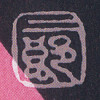
Takidaira's work signed with a stylised seal of his given name Jirō (二郎)
Takidaira (his family name) was a distinguished artist in the fields of woodblock print and papercut art, becoming well known after his series of distinctive paper cuts (kiri-e) in the Asahi newspaper during the 1970s. Born in 1921, he died in 2009 at the age of 88.
Search at Google for the artist's name in Japanese
Ryoko Kimura

Born in 1971, Ryoko Kimura graduated from Tokyo University of the Arts in 1997, with a specialisation in mural painting. Her style embodies traditional techniques, while her speciality, portrayal of the male form, adds tinges ranging from the comic to the erotic.
Search at Google for the artist's name in Japanese
eshi-masa
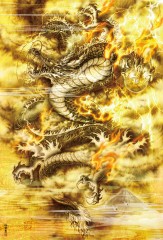
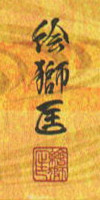
The characters 絵獅匡 of his brush name, with a seal
Self-described as a "dragon painter", this artist uses a brush name, styled as eshi-masa, an imaginative combination of characters meaning something like "picture-lion-master". After working as a product designer for Toyota, he set up his own company in 1999, and has since been producing artwork in a range of genres.
Search at Google for the artist's name in Japanese
Illustration
Izumi Kazumi
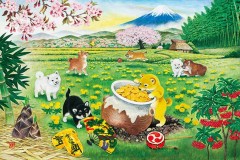
Izumi Kazumi is an animal artist who graduated from Osaka University fine arts department in 1984. Izumi is her family name.
Search at Google for the artist's name in Japanese
Hiroyuki Suwahara
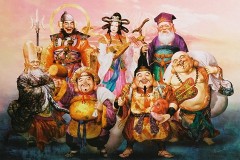
Born in Ibaraki, in 1969, Suwahara embarked on a career as a freelance illustrator in 1996. He has specialised in historical figures, especially from the Three Kingdoms story, and brings a very modern technique to some traditional themes.
Suwahara is his family name.
Search at Google for the artist's name in Japanese
Shinji Yamamoto
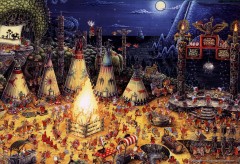
Born in Kyushu in 1980, Shinji Yamamoto graduated from the Nihon University College of Art, and immediately began a career as a commercial illustrator.
Search at Google for the artist's name in Japanese
Akiko Ikeda
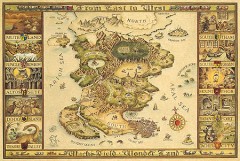
Born in Tokyo in 1950, Akiko Ikeda graduated from Aoyama Gakuin Women's Junior College in literature, and became a picture book author and artist. She is best known for creating the series of fantasy stories about the Wachifield cat Dayan and his friends.
Search at Google for the artist's name in Japanese
Youseki Miki

Born in Kyushu in 1966, Youseki Miki studied calligraphy, and after graduating from university embarked on a career as a commercial designer. He has developed a distinctive style of illustrated calligraphy with a contemporary, jovial touch. He writes his adopted brush name Youseki with nonstandard romanisation, to be read as the English word "you" plus "seki". (Miki is his family name, and his real name is Izuru.)
Search at Google for the artist's name in Japanese
Chihiro Iwasaki
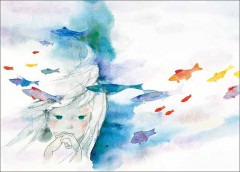
Born in Fukui Prefecture on the west coast of Japan in 1918, Chihiro Iwasaki showed an early aptitude for drawing. She later became well known for her illustrations, usually in a distinctive water colour style, of children and flowers. Although married twice, she continued to use her maiden family name of Iwasaki, which she usually wrote in hiragana (いわさき・ちひろ: I-wa-sa-ki Chi-hi-ro).
Search at Google for the artist's name in Japanese
Reina Sato

Born in 1983 in Fukushima, northern Japan, she graduated from art school, then worked as a commercial graphic designer before going freelance in 2008. She paints figures, animals, and anything from nature, and her individualistic use of colour gives them a jolly character.
Search at Google for the artist's name in Japanese
Taki

Taki is the brushname of a young freelance illustrator specialising in plants and animals, with a self-described style of "Japanese modern".
Search at Google for the artist's name in Japanese
Fantasy
Kagaya Yutaka

Born in Saitama (just north of Tokyo) in 1968, Kagaya spent his childhood in wonderment of the stars in the sky, and never stopped painting them. He has had a successful career as an illustrator for astronomical books and magazines, and many of his works have been turned into jigsaw puzzles, among other products. Since 1996, he has worked exclusively in the digital medium, using a Macintosh. Perhaps that is why he does not appear to sign his pictures.
He goes by his family name; his given name appears to be Yutaka, but in English you will also find him called Joh Kagaya (Jô is the Chinese reading of his name).
Search at Google for the artist's name in Japanese
Sasakura Teppei
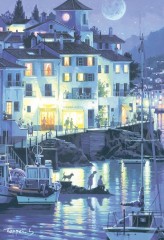
Born in Hyogo prefecture in 1954, Teppei earned a degree in commercial design from Musashino Art University, to begin a successful career as an illustrator. He has also had many exhibitions of his own work, in which European scenes in particular are prominent.
Sasakura is his family name - he signs his pictures "Teppei S."
Search at Google for the artist's name in Japanese
Kentaro Nishino
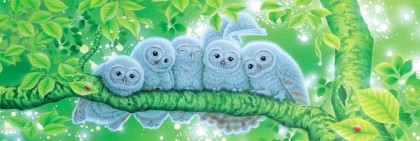
Kentaro Nishino was born in 1980, in Kanazawa on the Japan Sea coast, and graduated from the Academy of Art University in San Francisco in 2003. He takes his inspiration from nature, while lending his own air of fantasy.
Nishino is his family name, but he signs his work "Kentaro N".
Search at Google for the artist's name in Japanese
Kazuha Fukami

The artist Kazuha Fukami has produced a series of fantasy images of swirling figures, mostly women, some with swords, some not. According to her former website (kazuppo.net; no longer active) she was born in Tokushima (on the island of Shikoku) in June of 198x, and likes polar bears, cows, natural minerals and more.
This is almost certainly a brush name: the family name Fukami means "deep-well", and Kazuha ("ten-thousand leaves") is an alternative reading of the name attached to the famous collection of ancient Japanese poems, Man'yōshū.
Search at Google for the artist's name in Japanese
Yuu
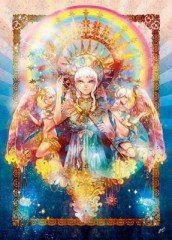
The young artist Yuu comes from Gunma Prefecture; she now lives in Tokyo, having graduated from Tama Art University with a degree in graphic design. No other details are readily forthcoming...
Search at Google for the artist's name in Japanese
Kayo Horaguchi
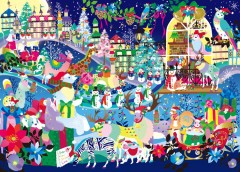
Born in Tokyo, Kayo Horaguchi started her career as a clothing designer, and gained experience in textile design and graphic design in the fashion business, until going freelance in 2006 as an illustrator and artist.
Search at Google for the artist's name in Japanese
Tsukiji Nao
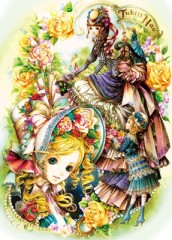
Nao Tsukiji (Nao is her family name) is a female manga artist, born in Fukuoka on March 11th. She does not reveal her age, but says that for as long as she can remember she has wanted to paint beautiful women.
Search at Google for the artist's name in Japanese
Kei
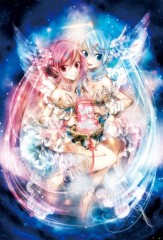
The only biographical information is that the artist was born in Hokkaido in 1981, and produces a range of artwork in the fantasy genre.
Search at Google for the artist's name in Japanese
Miki Okuda
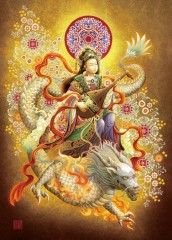
A young artist from Tokyo, she describes herself as wanting to produce fantastic images...
Search at Google for the artist's name in Japanese
Nishimura Noriko

Fascinated by the world of fantasy since she was a child, Nishimura has graduated from crayon to watercolour, and produces artwork of her imaginary worlds for a wide range of stationery, smartphone cases, and suchlike. Her brand name, used for the shop she has opened in Tokyo is 空想の街, or "Fantasy town", and she also adds a stylised "Märchen Art", referring to the German for "fairytale", which has found its way into Japanese. Nishimura is her family name.
Search at Google for the artist's name in Japanese
Photographers
Mitsuaki Iwagō
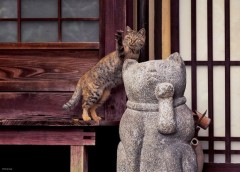
Mitsuaki Iwagō (born 1950) is a very well known Japanese wildlife photographer, whose photoessay on the Serengeti, "Natural Order on the African Plain" became an international best-seller. But he is also known for cute photographs of more domesticated animals...
(His family name is often written without the long-vowel mark, as Iwago.)
Search at Google for the artist's name in Japanese
About Japanese names
All modern Japanese names have two elements: a family name, followed by a given (or "personal") name. Almost all family names are written in Chinese characters (typically two characters), and so are the majority of given names. Historical names can be a bit more complicated, but invariably the pattern is "Big-endian", that is, the family name comes first, and the order goes from more general to more specific.
It has always seemed to me that a person's name is, well, their name, what they are called. So the obvious thing to do is simply to write down the name (as closely as possible) in Roman letters. This means that the family name comes first, which is not the usual way in English-speaking countries, but at least we can all say the name roughly the same. This is the usual practice with Chinese names, for example, so we have Mao Zedong and Chiang Kai-Shek, who are Mr Mao and Mr Chiang. And then, surname-first is sometimes distinctly preferable, as in telephone directories. Nonetheless, things are not really as clear-cut as this: in many parts of Europe, name order is much more fluid, and while names in Hungarian are written family name first (Bartok Bela, Liszt Ferenc), in neighbouring German-speaking areas the same names have generally been reversed, as in Franz Liszt (who, I believe, couln't even speak Hungarian).
So it seems that basically Japanese children learn at school that they should write their names family-name-last when in Roman letters. There has never been much consistency about this, though, and scholarly writing much more commonly preserves the original order; more recently the pendulum has swung back towards not reversing the name order for general use. Expect more confusion!
Artists' names
The tradition (as in the artistic world in general in Japan) is to use a "brush name", and this makes it even harder than usual to guess which is the (adopted) 'family' name if you don't know which order you are looking at. But there is another special difficulty with artists - whereas in everyday life in Japan people are known by their family names, artists usually go by their given names. So Hokusai is known by his (adopted) personal name Hokusai, and his (original) full name is Katsushika Hokusai, where Katsushika is not an original surname, but where he was born (now part of Tokyo). The trouble is that websites, art books, and other references sometimes call him "Katsushika Hokusai", sometimes "Hokusai Katsushika" (presumably because everyone knows Japanese names are written backwards). Then we find "Hokusai, Katsushika" which strongly implies that Hokusai is a family name - the end result is just more confusion.
What to do about it?
Where artists have become known by the 'backwards' family-name-last form, I've used it. Otherwise, I have generally kept the original form. But so that we know where we are, I have underlined the family name.
As usual, Wikipedia has a good general article on Japanese names.

